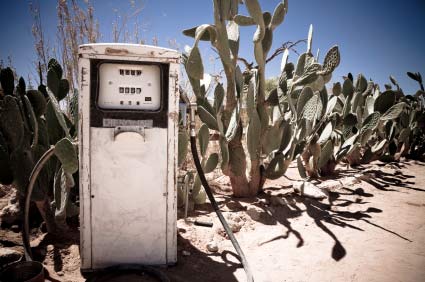In 1957 Oklahomans planted a large time capsule on the grounds of the Tulsa county courthouse with instructions that it be opened in 2007 to celebrate the state’s centennial. The principal object in the sealed vault was a Plymouth Belvedere. Unfortunately the time capsule proved not to be waterproofed. Instead of recovering a mint relic, the car proved to be a rusting wreck.
While Tulsans were naturally downhearted at the unveiling, there was a sadder spectacle that was generally overlooked. Placed on the car seat were jugs of gasoline.
Back in 1957, the far-sighted planners reasoned that, within the next 50 years, automobiles might no longer be powered by gasoline. The jugs of gasoline ensured the car could be operated in the distant future when gas stations might have all disappeared.
There was no need to worry. The gas stations are still around. We’re just as dependent on oil as ever. The only change is that America had moved away from leaded gasoline.
America occupied a highly enviable position in the post-war world. Its cities and businesses had emerged whole and hearty from the war. Its infrastructure hadn’t been wrecked by bombings and sabotage. We had the only intact economy in the Western world, and plenty of oil. There was little interest in conserving fuel now, especially with articles like “Now We Have Plenty of Oil,” which appeared in the Post in 1950.
“Turn up the oil burner. Fill the gas tank, the cigarette lighter, the kerosene range. Order a new diesel locomotive, a jar of cold cream, a jet plane, and make free with petroleum products any way you fancy. Forget that rumor you heard just a few years back—the one that predicted that we would shortly run out of oil and into calamity. It was not true. There is oil in quantity under American soil. Having had less than a hundred years to regularize its cycles, the calendar of perpetual petroleum alarm and reassurance is not yet as accurate as a barometer, but at this points it reads calm, comfort and all the gasoline you want. The next cycle of worry over oil shortage may be a decade or more away, to be followed no doubt by surplus, to be followed no doubt by shortage, to be —
“Anyway, right now oil is easy, and this should be a powerful load off the national mind. The importance of whether or not we have enough oil in America grows greater every year.
“… perhaps it is permissible to point out that the record of oil ups and downs is at least odd, if not downright hilarious. No decade has passed in the present century without some authority writing off our oil future as failing and soon doomed. Crankcases today are full of oil that was once seriously described as nonexistent.
“Take the notable warning of 1919, when the chief geologist of the United States Geological Survey flatly predicted complete oil exhaustion in this country by 1936. Or the comparatively recent fright of former Secretary of the Interior Ickes in 1943, who solemnly divided known oil reserves by consumption and pointed out that we had a supply good for only fourteen years.”
The writer spoke of unlimited oil, and new fields of crude that had recently been located in Texas. What he failed to tell readers was that, since four years earlier, the United States was starting to consume more oil than it could produce domestically. As early as 1946, we were losing our energy independence.
Even so, the confident tone could still be heard in 1962. In that year, another Post article, “The Oil of the Arab,” addressed the rising nationalism of Arab nations, which were providing us with most of our gasoline. He quoted Sheik Abdullah H. Taliki, Saudi Arabia director of oil:
“’Allah made nothing without cause,’ he says. ‘He made the great desserts that are useless to man. But he buried oil beneath them. It is Arab oil. It must be used for the Arab’s benefit. Today others can use our oil to further their interests, which may not coincide with ours.’
“The oil, buried in a great basin that stretches from the southern slopes of Turkey’s Taurus Mountains to the shores of the Arabian Sea, and from Iran’s eastern borders to Saudi Arabia’s western shore, constitutes what is probably the world’s greatest reservoir of mineral wealth. Reserves estimated at 181,000,000,000 barrels, two thirds of the free world’s known oil supply, have already been discovered; millions of square miles, on land in the waters of the Persian Gulf, remain to be explored. Tiny Kuwait, a sun-parched desert little bigger than Connecticut, has proven reserves of 62,000,000,000 barrels, exceeding the total reserves of North and South America combined. Beneath the dunes and bare gravel plains of Saudi Arabia lie 50,000,000,000 barrels more. Iraq has 25,000,000,000 barrels in reserve, Iran 35,000,000,000.
“The total reserves in the United States are estimated at 33,500,000,000.
“’Some day,’ he says, ‘we will unite. Once we are strong enough to shut down all the wells, and close the Suez Canal and shut off the pipelines—even if only for a few days—the companies will suddenly see a great light. The world cannot live without the Mideast’s oil.'”
Well, it was easy for the author to see why the Arabs would never succeed in exerting its power.
“The weakness in Mr. Tariki’s position lies in the fact that at the moment there is more oil available than the world can use…”
Become a Saturday Evening Post member and enjoy unlimited access. Subscribe now



